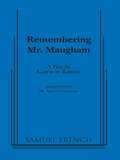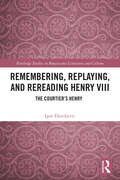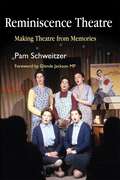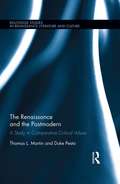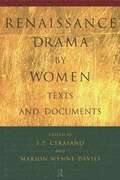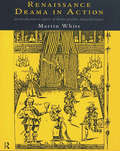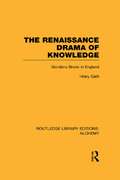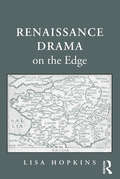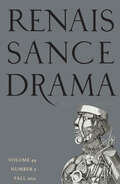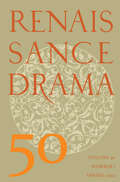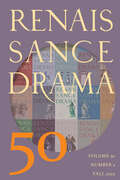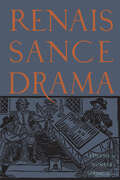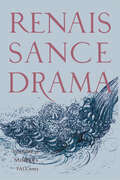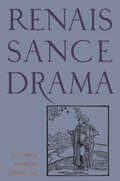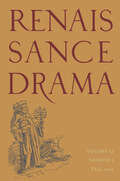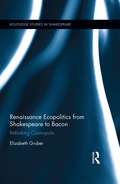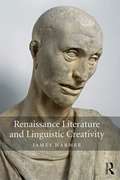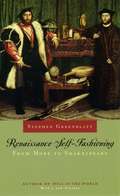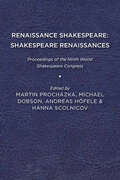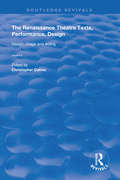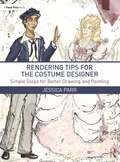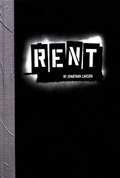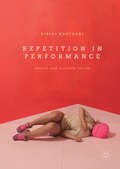- Table View
- List View
Remembering Mr. Maugham
by Garson KaninMemoirCharacters: 2 maleRemembering Mr. Maugham is an intimate glimpse into the life of W. Somerset Maugham - one of the most brilliant, prolific and secretive writers of the 20th century. This graceful two-character, one-act play adapted by Garson Kanin from his memoir is a treasure trove of private conversations, amusing anecdotes and candid recollections of his beloved friend and confidant. Through decades of friendship, Kanin and Maugham poignantly reminisce about life, art and the unconquerable human spirit.
Remembering, Replaying, and Rereading Henry VIII: The Courtier’s Henry (Routledge Studies in Renaissance Literature and Culture)
by Igor DjordjevicThis book begins by asking about the memorial issues involved in the replaying of an old history play, Shakespeare and Fletcher’s Henry VIII, at the Globe on 29 July 1628, but it is not primarily concerned with the memory of a single individual, George Villiers, 1st Duke of Buckingham who paid for the production, nor even of a single day, when he seemed to try to evoke the memories of a small group of people gathered at the theatre for a singular purpose. In order to resolve the mystery of what a group of people thought about the past in a single moment in time, this book studies Elizabethan, Jacobean, and Caroline textual recollections that inform the moment in 1628. Tracing the ways in which Henry VIII was remembered across these years reveals a dominant approach to reading history in the early modern period, and the varied purposes of memorial activity itself.
Reminiscence Theatre: Making Theatre from Memories
by Faith Gibson Pam SchweitzerReminiscence theatre is about seeing and realising the dramatic potential in real life stories. It takes verbatim memories as the basis for theatre scripts, using the experiences of older people as a source of artistic productions and therapeutic creativity. This book is a comprehensive guide to the nature, practice and therapeutic effects of reminiscence theatre. Drawing on examples from a range of real-life case studies, Pam Schweitzer provides practical advice on the process of taking an oral history, creating from it a written script and developing that into a dramatic production, on whatever scale. The book outlines five components of key significance that the form affords: artistic development through creating original productions; cultural development, by creating reminiscence theatre in multi-cultural contexts, including dual-language productions; educational development through the intergenerational sharing and enactment of memories; psycho-social development for older people by reliving and reshaping past experiences; and health care, by using improvised reminiscence drama therapeutically with people with dementia and their carers. This book will be of great interest to theatre workers, social work professionals and carers of older people, arts therapy practitioners and students in these fields.
The Renaissance and the Postmodern: A Study in Comparative Critical Values (Routledge Studies in Renaissance Literature and Culture)
by Thomas L Martin Duke PestaThe Renaissance and the Postmodern reconsiders postmodern readings of Renaissance texts by engaging in a dialectics the authors call comparative critical values. Rather than concede the contemporary hierarchy of theory over literature, the book takes the novel approach of consulting major Renaissance writers about the values at work in postmodern representations of early modern culture. As criticism seeks new directions and takes new forms, insufficient attention has been paid to the literary and philosophical values won and lost in the exchanges. One result is that the way we understand the logical connections, the literary textures, and the philosophical impulses that make up the literature of writers like Spenser, Shakespeare, and Milton has fundamentally changed. Examining theoretical debates now in light of polemical controversies then, the book goes beyond earlier studies in that it systematically examines the effects of these newer critical approaches across their materialist, historicist, deconstructive, and psychoanalytic manifestations. Bringing gravity and focus to this question of critical continuities and discontinuities, each chapter counterposes one major Renaissance voice with a postmodern one to probe these issues and with them the value of the cultural past. As voices on both sides of the historical divide illuminate key differences between the Renaissance and the Postmodern, a critical model emerges from the book to re-engage this period’s humane literature in a contemporary context with intellectual rigor and a renewed sense of cultural enrichment.
Renaissance Drama and the English Church Year
by Rudolph Chris Hassel Jr.Evidence encouraging a new and productive approach to Renaissance drama has long been available in the records of Renaissance court perfon-nances compiled by E. K. Chambers and Gerald Eades Bentley.' Over fifty years ago Chambers noticed the persistent correlation between the dates of dramatic performance at Elizabeth's court and certain liturgical festivals of the English church year. Whether in Whitehall or elsewhere, the twelve days of Christmas from the Nativity to the Epiphany, were a season of high revels.... Twelfth Night [6 Jan.] itself, with St. Stephen's [26 Dec.] , St. John's [27 Dec.], Innocents' [28 Dec.], and New Year's Day [circumcision], were regularly appointed for plays and masks, which often overflowed on to other nights during the period.... The revels were renewed for Candlemas [2 Feb.] and for Shrovetide [Sunday, Monday, and Tuesday before Ash Wednesday] , either at the Christmas headquarters or at some other palace to which the court had meanwhile removed. . . . Easter, with the distribution of alms and washing of feet on Maunday Thursday, and Whitsuntide, were kept as ecclesiastical, rather than secular feasts. [1: 19-201 Gradually emerging during the sixteenth century, this calendar tradition seems to have peaked in the period 1570-85, continued strong until Elizabeth's death, diminished and changed somewhat during the Jacobean and Caroline periods, and then disappeared completely after 1640.
Renaissance Drama by Women: Texts and Documents
by S. P. Cerasano Marion Wynne-Davies<p>Gathered for the first time in this unique volume are plays and documents which show that, contrary to traditional thinking, women did participate in the theatrical culture of the Renaissance. Women were authors, translators, performers, spectators, and even part-owners of theatres. <p>Included in this meticulously edited volume are four full-length plays, a fragment of a translation from Seneca by Queen Elizabeth I, a masque written for performance by a ladies’ school before Queen Anne and a collection of historical documents. <p><i>Renaissance Drama by Women: Texts and Documents</i> is the first collection to offer such a wealth of literary and historical material. The editors assist the reader in understanding the richness of the texts by providing modernized spellings, full notes, annotations of unfamiliar words and phraseology, biographical essays and a bibliography. This volume will be invaluable to students and scholars of Renaissance studies, theatre history and women’s studies.</p>
Renaissance Drama By Women: Texts And Documents
by S. P. Cerasano Marion Wynne-DaviesRenaissance Drama By Women is a unique volume of plays and documents. For the first time, it demonstrates the wide range of theatrical activity in which women were involved during the Renaissance period. It includes full-length plays, a translated fragment by Queen Elizabeth I, a masque, and a substantial number of historical documents. With full and up-to-date accompanying critical material, this collection of texts is an exciting and invaluable resource for use in both the classroom and research. Special features introduced by the editors include: * introductory material to each play * modernized spellings * extensive notes and annotations * biographical essays on each playwright * a complete bibliography Methodically and authoritatively edited by S.P. Cerasano and Marion Wynne-Davies, Renaissance Drama by Women is a true breakthrough for the study of women's literature and performance.
Renaissance Drama in Action: An Introduction To Aspects Of Theatre Practice And Performance
by Martin WhiteRenaissance Drama in Action is a fascinating exploration of Renaissance theatre practice and staging. Covering questions of contemporary playhouse design, verse and language, staging and rehearsal practices, and acting styles, Martin White relates the characteristics of Renaissance theatre to the issues involved in staging the plays today. This refreshingly accessible volume: * examines the history of the plays on the English stage from the seventeenth century to the present day * explores questions arising from reconstructions, with particular reference to the new Globe Theatre * includes interviews with, and draws on the work and experience of modern theatre practitioners including Harriet Walter, Matthew Warchus, Trevor Nunn, Stephen Jeffreys, Adrian Noble and Helen Mirren * includes discussions of familiar plays such as The Duchess of Malfi and 'Tis Pity She's A Whore, as well as many lesser known play-texts Renaissance Drama in Action offers undergraduates and A-level students an invaluable guide to the characteristics of Elizabethan and Jacobean drama, and its relationship to contemporary theatre and staging.
The Renaissance Drama of Knowledge: Giordano Bruno in England (Routledge Library Editions: Alchemy)
by Hilary GattiGiordano Bruno’s visit to Elizabethan England in the 1580s left its imprint on many fields of contemporary culture, ranging from the newly-developing science, the philosophy of knowledge and language, to the extraordinary flowering of Elizabethan poetry and drama. This book explores Bruno's influence on English figures as different as the ninth Earl of Northumberland, Thomas Harriot, Christopher Marlowe and William Shakespeare. Originally published in 1989, it is of interest to students and teachers of history of ideas, cultural history, European drama and renaissance England. Bruno's work had particular power and emphasis in the modern world due to his response to the cultural crisis which had developed - his impulse towards a new ‘faculty of knowing’ had a disruptive effect on existing orthodoxies – religious, scientific, philosophical, and political.
Renaissance Drama on the Edge
by Lisa HopkinsRecurring to the governing idea of her 2005 study Shakespeare on the Edge, Lisa Hopkins expands the parameters of her investigation beyond England to include the Continent, and beyond Shakespeare to include a number of dramatists ranging from Christopher Marlowe to John Ford. Hopkins also expands her notion of liminality to explore not only geographical borders, but also the intersection of the material and the spiritual more generally, tracing the contours of the edge which each inhabits. Making a journey of its own by starting from the most literally liminal of physical structures, walls, and ending with the wholly invisible and intangible, the idea of the divine, this book plots the many and various ways in which, for the Renaissance imagination, metaphysical overtones accrued to the physically liminal.
Renaissance Drama, volume 49 number 2 (Fall 2021)
by Renaissance DramaThis is volume 49 issue 2 of Renaissance Drama. Renaissance Drama explores the rich variety of theatrical and performance traditions and practices in early modern Europe and intersecting cultures. The sole scholarly journal devoted to the full expanse of Renaissance theatre and performance, the journal publishes articles that extend the scope of our understanding of early modern playing, theatre history, and dramatic texts and interpretation, encouraging innovative theoretical and methodological approaches to these traditions, examining familiar works, and revisiting well-known texts from fresh perspectives.
Renaissance Drama, volume 50 number 1 (Spring 2022)
by Renaissance DramaThis is volume 50 issue 1 of Renaissance Drama. Renaissance Drama explores the rich variety of theatrical and performance traditions and practices in early modern Europe and intersecting cultures. The sole scholarly journal devoted to the full expanse of Renaissance theatre and performance, the journal publishes articles that extend the scope of our understanding of early modern playing, theatre history, and dramatic texts and interpretation, encouraging innovative theoretical and methodological approaches to these traditions, examining familiar works, and revisiting well-known texts from fresh perspectives.
Renaissance Drama, volume 50 number 2 (Fall 2022)
by Renaissance DramaThis is volume 50 issue 2 of Renaissance Drama. Renaissance Drama explores the rich variety of theatrical and performance traditions and practices in early modern Europe and intersecting cultures. The sole scholarly journal devoted to the full expanse of Renaissance theatre and performance, the journal publishes articles that extend the scope of our understanding of early modern playing, theatre history, and dramatic texts and interpretation, encouraging innovative theoretical and methodological approaches to these traditions, examining familiar works, and revisiting well-known texts from fresh perspectives.
Renaissance Drama, volume 51 number 1 (Spring 2023)
by Renaissance DramaThis is volume 51 issue 1 of Renaissance Drama. Renaissance Drama explores the rich variety of theatrical and performance traditions and practices in early modern Europe and intersecting cultures. The sole scholarly journal devoted to the full expanse of Renaissance theatre and performance, the journal publishes articles that extend the scope of our understanding of early modern playing, theatre history, and dramatic texts and interpretation, encouraging innovative theoretical and methodological approaches to these traditions, examining familiar works, and revisiting well-known texts from fresh perspectives.
Renaissance Drama, volume 51 number 2 (Fall 2023)
by Renaissance DramaThis is volume 51 issue 2 of Renaissance Drama. Renaissance Drama explores the rich variety of theatrical and performance traditions and practices in early modern Europe and intersecting cultures. The sole scholarly journal devoted to the full expanse of Renaissance theatre and performance, the journal publishes articles that extend the scope of our understanding of early modern playing, theatre history, and dramatic texts and interpretation, encouraging innovative theoretical and methodological approaches to these traditions, examining familiar works, and revisiting well-known texts from fresh perspectives.
Renaissance Drama, volume 52 number 1 (Spring 2024)
by Renaissance DramaThis is volume 52 issue 1 of Renaissance Drama. Renaissance Drama explores the rich variety of theatrical and performance traditions and practices in early modern Europe and intersecting cultures. The sole scholarly journal devoted to the full expanse of Renaissance theatre and performance, the journal publishes articles that extend the scope of our understanding of early modern playing, theatre history, and dramatic texts and interpretation, encouraging innovative theoretical and methodological approaches to these traditions, examining familiar works, and revisiting well-known texts from fresh perspectives.
Renaissance Drama, volume 52 number 2 (Fall 2024)
by Renaissance DramaThis is volume 52 issue 2 of Renaissance Drama. Renaissance Drama explores the rich variety of theatrical and performance traditions and practices in early modern Europe and intersecting cultures. The sole scholarly journal devoted to the full expanse of Renaissance theatre and performance, the journal publishes articles that extend the scope of our understanding of early modern playing, theatre history, and dramatic texts and interpretation, encouraging innovative theoretical and methodological approaches to these traditions, examining familiar works, and revisiting well-known texts from fresh perspectives.
Renaissance Ecopolitics from Shakespeare to Bacon: Rethinking Cosmopolis (Routledge Studies in Shakespeare)
by Elizabeth D. GruberThe work of Shakespeare and his contemporaries has often been the testing-ground for innovations in literary studies, but this has not been true of ecocriticism. This is partly because, until recently, most ecologically minded writers have located the origins of ecological crisis in the Enlightenment, with the legacies of the Cartesian cogito singled out as a particular cause of our current woes. Traditionally, Renaissance writers were tacitly (or, occasionally, overtly) presumed to be oblivious of environmental degradation and unaware that the episteme—the conceptual edifice of their historical moment—was beginning to crack. This perception is beginning to change, and Dr. Guber's work is poised to illuminate the burgeoning number of ecocritical studies devoted to this period, in particular, by showing how the classical concept of the cosmopolis, which posited the harmonious integration of the Order of Nature (cosmos) with the Order of Society (polis), was at once revived and also systematically dismantled in the Renaissance. Renaissance Ecopolitics from Shakespeare to Bacon: Rethinking Cosmopolis demonstrates that the Renaissance is the hinge, the crucial turning point in the human-nature relationship and examines the persisting ecological consequences of the nature-state’s demise.
Renaissance Literature and Linguistic Creativity
by James HarmerRenaissance Literature and Linguistic Creativity interrogates notions of linguistic creativity as presented in English literary texts of the late sixteenth century. It considers the reflections of Renaissance English writers upon the problem of how linguistic meaning is created in their work. The book achieves this consideration by placing its Renaissance authors in the context of the dominant conceptualisation of the thought-language relationship in the Western tradition: namely, that of 'introspection'. In taking this route, author James Harmer undertakes to provide a comprehensive overview of the notion of 'introspection' from classical times to the Renaissance, and demonstrates how complex and even strange this notion is often seen to be by thinkers and writers. Harmer also shows how poetry and literary discourse in general stands at the centre of the conceptual consideration of what linguistic thinking is. He then argues, through a range of close readings of Renaissance texts, that writers of the Shakespearean period increase the fragility of the notion of 'introspection' in such a way as to make the prospect of any systematic theory of meaning seem extremely remote. Embracing and exploring the possibility that thinking about meaning can only occur in the context of extreme cognitive and psychological limitation, these texts emerge as proponents of a human mind which is remarkably free in its linguistic nature; an irresistible mode of life unto itself. The final argumentative stratum of the book explores the implications of this approach for understanding the relationship between literary criticism, philosophy, and other kinds of critical activity. Texts discussed at length include Edmund Spenser's The Faerie Queene and shorter poetry, George Chapman's Ovids Banquet of Sence, Shakespeare's Titus Andronicus and Hamlet, and John Donne's Elegies.
Renaissance Self-Fashioning: From More to Shakespeare
by Stephen GreenblattRenaissance Self-Fashioning is a study of sixteenth-century life and literature that spawned a new era of scholarly inquiry. Stephen Greenblatt examines the structure of selfhood as evidenced in major literary figures of the English Renaissance—More, Tyndale, Wyatt, Spenser, Marlowe, and Shakespeare—and finds that in the early modern period new questions surrounding the nature of identity heavily influenced the literature of the era. Now a classic text in literary studies, Renaissance Self-Fashioning continues to be of interest to students of the Renaissance, English literature, and the new historicist tradition, and this new edition includes a preface by the author on the book's creation and influence. "No one who has read [Greenblatt's] accounts of More, Tyndale, Wyatt, and others can fail to be moved, as well as enlightened, by an interpretive mode which is as humane and sympathetic as it is analytical. These portraits are poignantly, subtly, and minutely rendered in a beautifully lucid prose alive in every sentence to the ambivalences and complexities of its subjects."—Harry Berger Jr., University of California, Santa Cruz
Renaissance Shakespeare/Shakespeare Renaissances: Proceedings of the Ninth World Shakespeare Congress
by Stanley Wells Joel Rodgers Randall Martin Robert Darcy Atsuhiko Hirota Darryl Chalk Supriya Chaudhuri Kimberly R. West Sukanta Chaudhuri Margaret Shewring Richard Fotheringham Ros King James J. Marino Brian Walsh Eleanor Collins M. A. Katritzky Martin Hilský Ann Jennalie Cook Vlasta Gallerová Karel Kríž Robert Sturua Jean-Christophe Mayer Galz Engler Madalina Nicolaescu Kaori Kobayashi Patrick Lonergan Zeno Ackermann Tina Krontiris Emily Oliver Shaul Bassi Barry Freeman Carla Della Gatta Cristiane Busato Smith Sharon O'Dair Emma Depledge Anna Cetera Courtney Lehmann Poonam Trivedi Bi-Qi Beatrice Lei Graham Holderness Jill L. Levenson Hersh ZeifmanSelected contributions to the Ninth World Shakespeare Congress, which took place in July 2011 in Prague, represent the contemporary state of Shakespeare studies in thirty-eight countries worldwide. Apart from readings of Shakespeare’s plays and poems, more than forty chapters map Renaissance contexts of his art in politics, theater, law, or material culture and discuss numerous cases of the impact of his works in global culture from the Americas to the Far East, including stage productions, book culture, translations, film and television adaptations, festivals, and national heritage. The last section of the book focuses on the afterlife of Shakespeare in the work of the leading British dramatist Tom Stoppard. Published by University of Delaware Press. Distributed worldwide by Rutgers University Press.
The Renaissance Theatre: Volume II: Design, Image and Acting (Routledge Revivals)
by Christopher CairnsOriginally published in 1999, this book is a critical analysis of Renaissance theatre, including chapters on speaking theatres, performing theatre and redesigning Shakespeare.
Rendering Tips for the Costume Designer: Simple Steps for Better Drawing and Painting
by Jessica ParrRendering Tips for the Costume Designer: Simple Steps for Better Drawing and Painting is a guide for students and costume designers who want to improve their drawing, painting, and rendering skills. The book is divided into three sections – Drawing Tips, Painting Tips, and Linework Tips – and includes detailed step-by-step instructions for chapters such as "How to Draw Faces and Hair," "How to Draw Hands," and "How to Draw Feet and Shoes". This format allows readers to pick and choose which techniques to study, enabling them to focus on the areas that give them the most difficulty. Filled with practical information and over 100 illustrations, this reference guide can be used in conjunction with any figure drawing method or painting media. Within these pages, readers will find the answers to the most common rendering questions: Where do the shadows go? How do I make my figures look less stiff? How do I draw patterned fabric? Rendering Tips for the Costume Designer is an invaluable resource for students in Costume Rendering and Costume Design courses, along with professional costume designers looking to improve their rendering skills.
Rent
by Jonathan LarsonThe full story of Rent, Jonathan Larson's musical opera, including the libretto and biographies of the original cast members.<P><P> Pulitzer Prize Winner
Repetition in Performance
by Eirini KartsakiThis book explores repetition in contemporary performance and spectatorship. It offers an impassioned account of the ways in which speech, movement and structures repeat in performances by Pina Bausch, Anne Teresa De Keersmaeker, Lone Twin Theatre, Haranczak/Navarre and Marco Berrettini. It addresses repetition in relation to processes of desire and draws attention to the forces that repetition captures and makes visible. What is it in performances of repetition that persuades us to return to them again and again? How might we unpack their complexities and come to terms with their demands upon us? While considering repetition in relation to the difficult pleasures we derive from the theatre, this book explores ways of accounting for such experiences of theatre in memory and writing.
